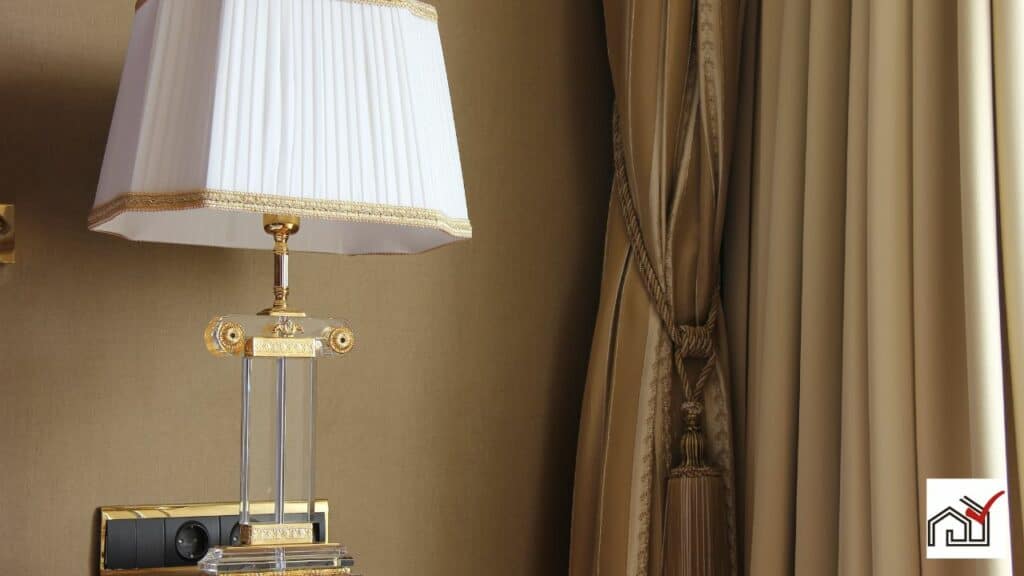White lampshades may turn yellow due to material aging, environmental exposure, and the type of light bulb used. Materials like fabric or paper can naturally degrade over time, leading to discoloration. Sunlight’s UV rays can also cause yellowing. Additionally, heat from light bulbs can change the shade’s color.
To prevent this, regular cleaning and upkeep are recommended. This text will further detail these factors and preventive strategies.
The Aging of Materials
Materials, such as the fabrics and plastics in lampshades, naturally age due to environmental factors. They change over time when exposed to heat, UV light, and dust. Light bulbs can particularly speed up the aging of lampshades, as the heat they emit may lead to discoloration, often noticeable as yellowing on white or light shades.
UV light exposure can further intensify this yellowing, especially when lampshades are in direct sunlight. This reaction can change the chemical structure of the materials, affecting their color to varying degrees based on the amount of heat and UV light they receive.
Dust accumulation also plays a role in yellowing lampshades. Dust can stick to the surface, eventually becoming embedded in the material and making the shade look dull and yellowed. This effect is more visible on lighter shades due to the stark contrast with their original color.
To reduce these effects, lampshade placement should be strategic to avoid direct light, and they should be cleaned gently. For example, Zote laundry soap can be used to clean yellowed lampshades, but care should be taken not to apply too much pressure and to rinse thoroughly to avoid residue.
Environmental Factors
Environmental factors significantly contribute to the yellowing of white lampshades over time. Heat from light bulbs, especially high-wattage ones, can alter the chemical makeup of plastic lampshades, leading to a yellow discoloration. Additionally, ultraviolet rays from sunlight can degrade dyes and pigments, causing the lampshades to fade or turn yellow, particularly if they are near windows or in direct sunlight for extended periods.
Dust and airborne particles also add to the yellowing effect by sticking to the surface and potentially becoming embedded in the material, despite regular cleaning efforts. The rate of yellowing may vary depending on the lampshade’s location and exposure to these factors, with those in less exposed areas likely to remain white for a longer period.
Light Bulb Effects
The type of light bulb used can affect the yellowing of white lampshades. Incandescent bulbs produce a lot of heat, which can cause chemical changes in temperature-sensitive materials like plastic, resulting in yellowing. Some bulbs emit UV light that can degrade materials, similar to sunlight, but less intensely. Dust on lampshades can also retain heat and contribute to yellowing. Cleaning can help, but the bulb type is important.
Using LED or fluorescent bulbs can reduce yellowing because they emit less heat and UV radiation. These bulbs are also more energy-efficient and are better for maintaining the color of lampshades. The relationship between bulb type and lampshade material is important for preserving the appearance of a room.
Cleaning and Maintenance
Regular cleaning and maintenance are crucial for preventing the yellowing of white lampshades caused by dust and heat. Dust accumulation can lead to dullness and discoloration, especially when combined with the heat from light bulbs. To combat this, regular dusting is recommended.
For deeper cleaning, baking soda can be used as a mild abrasive to remove yellowing. Vinegar, due to its acidic nature, can help dissolve residue and bring back the lampshade’s original brightness. Zote laundry soap is also effective, particularly for fabric shades, as it contains optical brighteners and a bleach alternative.
When using these cleaning agents, it’s important to apply them carefully and make sure they are appropriate for the lampshade’s material. Thorough rinsing is necessary to prevent any remaining cleaning residue, which could attract more dust or cause additional yellowing.
Maintaining a consistent cleaning routine will help preserve the appearance and longevity of white lampshades. Always refer to the manufacturer’s care instructions and consider the material of the lampshade to avoid any potential damage during cleaning.
Yellowing Prevention Tips
To prevent white lampshades from turning yellow, use these tips:
- Use LED bulbs to reduce heat, which can cause yellowing.
- Place lampshades away from direct sunlight to avoid UV damage.
- Dust regularly to keep the lampshade clean and prevent a dull appearance.
- Choose UV-resistant materials for lampshades to protect against sun damage.
- Rotate the lampshade occasionally for even exposure to light and the environment.
Following these steps will help maintain the color and appearance of white lampshades.
Professional Restoration Options
If a white lampshade turns yellow, professional cleaning services can help restore it by using specialized techniques to remove discoloration. This is especially useful for valuable or delicate lampshades that might be damaged by home cleaning methods.
Professional cleaners use advanced methods and products to deep clean and remove the yellow tint, then apply whitening treatments to bring back the original color.
Some services also offer UV protection treatments to prevent future yellowing caused by sunlight. This is beneficial for lampshades that are often in the sun or near windows.
For valuable or delicate lampshades, using professional cleaners is the safest approach. They have the knowledge to handle the lampshade properly and use the best methods for restoration. Choosing professional restoration helps maintain the appearance and durability of the lampshade as part of the home decor.





